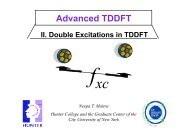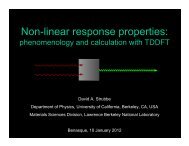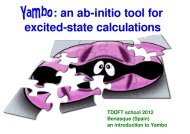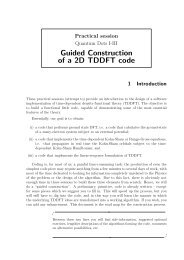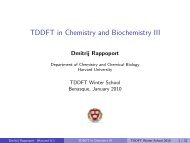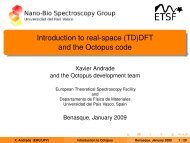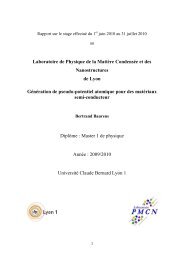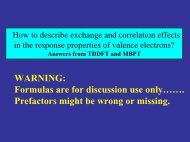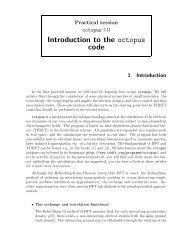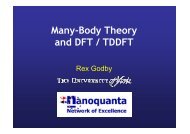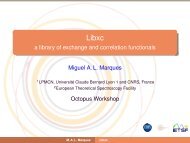Real-space multigrid methods for DFT and TDDFT: - TDDFT.org
Real-space multigrid methods for DFT and TDDFT: - TDDFT.org
Real-space multigrid methods for DFT and TDDFT: - TDDFT.org
Create successful ePaper yourself
Turn your PDF publications into a flip-book with our unique Google optimized e-Paper software.
<strong>Real</strong>-<strong>space</strong> <strong>multigrid</strong> <strong>methods</strong> <strong>for</strong> <strong>DFT</strong> <strong>and</strong> TD<strong>DFT</strong>:<br />
Tuomas Torsti<br />
CSC – The finnish IT center <strong>for</strong> Science<br />
Laboratory of Physics, Helsinki University of Technology<br />
http://www.csc.fi/physics/mika
Acknowledgements<br />
• For Funding<br />
– CSC – The finnish IT center <strong>for</strong> Science<br />
– COMP, Helsinki University of<br />
Technology<br />
• For advice<br />
– Martti Puska (COMP)<br />
– Risto Nieminen (COMP)<br />
– Janne Ignatius (CSC)<br />
• For collaboration using MIKA/cyl2<br />
– Bo Hellsing (Chalmers)<br />
– Vanja Lindberg (Växjö, Chalmers)<br />
– Nerea Zabala (San Sebastian)<br />
– Eduardo Og<strong>and</strong>o (Bilbao)<br />
– Paula Havu (COMP)<br />
– Tero Hakala (COMP)<br />
• For development of RQMG<br />
– Mika Heiskanen (then COMP)<br />
• For collaboration in development of<br />
MIKA/r<strong>space</strong><br />
– Sampsa Riikonen (now San Sebastian)<br />
– Ville Lehtola (COMP)<br />
– Kaarle Ritvanen (COMP)<br />
• For work done with MIKA/RS2Dot<br />
– Henri Saarikoski<br />
– Esa Räsänen<br />
• For response iterations<br />
– Eckhardt Krotscheck (Linz)<br />
– Michael Aichinger (Linz)<br />
• For work done with MIKA/doppler<br />
– Ilja Makkonen
Motivation <strong>for</strong> using real-<strong>space</strong> grids<br />
• With uni<strong>for</strong>m grids the control of the ”basis set” is simple : Only one<br />
parameter (the grid spacing h)<br />
• Flexible choice of boundary conditions : cluster, wire, surface, bulk.<br />
• cluster<br />
• wire<br />
• surface<br />
• bulk<br />
• ...<br />
• Parallelization using domain decomposition<br />
• It is possible to use nonuni<strong>for</strong>m grids to refine the mesh close to atomic<br />
nuclei or ”hard” pseudopotential, <strong>and</strong>/or to push the vacuum boundary far<br />
away in cluster calculations :<br />
• adaptive grids<br />
• composite grids<br />
• finite elements<br />
• Multigrid techniques can be used to obtain optimal scaling <strong>for</strong> PDE’s<br />
• Natural framework <strong>for</strong> Order-N (localized orbitals required)
R<br />
∇ 2 V =<br />
=<br />
f<br />
− ∇<br />
f<br />
2<br />
V<br />
∇ 2 ( V<br />
fine<br />
+ Vcoarse)<br />
= f<br />
⇒ ∇ 2 V =<br />
Multigrid <strong>methods</strong><br />
A. Br<strong>and</strong>t. Math. Comput. 31, 333 (1977)., T. L. Beck. Rev. Mod. Phys. 72, 1041 (2000).<br />
W. L. Briggs et al., A Multigrid Tutorial, Second Edition. (SIAM 2000).<br />
As a simple example, take the Poisson<br />
equation<br />
Simple relaxation schemes (e.g. the<br />
Gauss-Seidel method) efficiently remove<br />
the short wavelength components of the<br />
residual<br />
(they are good smoothers), while critical<br />
slowing down occurs <strong>for</strong> the long<br />
wavelength components. Solution: treat<br />
long wavelength components of V on a<br />
coarse grid<br />
coarse<br />
R fine<br />
The idea can be applied recursively (Vcycle).<br />
Linear scaling with problem size<br />
can be acchieved with the full-<strong>multigrid</strong><br />
method.
Classification of MG-<strong>methods</strong> <strong>for</strong> the eigenproblem<br />
• Steepest descent (or CG or RMM-DIIS) with MGpreconditioning<br />
e.g. Bernholc et al., Phys. Rev. B 54 14362 (1996)<br />
• Full approximation storage<br />
A. Br<strong>and</strong>t et al. SIAM J. Sci. Comput. 4, 244 (1983)<br />
J. Wang <strong>and</strong> T. L. Beck , J. Chem. Phys. 112, 9223 (2000)<br />
• Rayleigh Quotient Multigrid method (RQMG)<br />
J. M<strong>and</strong>el <strong>and</strong> S. F. Cormick, J. Comput. Phys. 80, 442 (1989).<br />
M. Heiskanen et al., Phys. Rev. B 63, 245106, (2001).
• Discretized Schrödinger equation<br />
• With search vector d vary α to minimize<br />
the Rayleigh quotient<br />
Rayleigh quotient <strong>multigrid</strong> method<br />
J. M<strong>and</strong>el <strong>and</strong> S. F. Cormick, J. Comput. Phys. 80, 442 (1989).<br />
M. Heiskanen et al., Phys. Rev. B 63, 245106, (2001).<br />
R(<br />
α)<br />
=<br />
u + αd<br />
H u + αd<br />
u + αd<br />
B u + αd<br />
• Coordinate relaxation: choose a coordinate vector d=e.<br />
f<br />
• RQMG – method : on coarse grids minimize the fine grid RQ with: d = Ic<br />
e<br />
• The fine grid Rayleigh quotient can be evaluated entirely on the coarse grid :<br />
R(<br />
α)<br />
=<br />
u<br />
f<br />
u<br />
f<br />
H<br />
B<br />
f<br />
f<br />
u<br />
u<br />
f<br />
f<br />
+ 2α<br />
I<br />
+ 2α<br />
I<br />
c<br />
f<br />
c<br />
f<br />
H<br />
B<br />
f<br />
f<br />
u<br />
u<br />
f<br />
f<br />
e<br />
e<br />
c<br />
c<br />
2<br />
+ α<br />
2<br />
+ α<br />
• If eigenpairs other than the lowest one are required, add a penalty functional to take<br />
care of the orthogonality requirement:<br />
R[<br />
u<br />
u<br />
Hu = εBu<br />
Hu<br />
k + 1 k + 1<br />
k + 1] = +<br />
uk<br />
+ 1<br />
Buk<br />
+ 1<br />
∑<br />
e<br />
e<br />
c<br />
c<br />
H<br />
c<br />
c<br />
B e<br />
e<br />
2<br />
k ui<br />
uk<br />
+ 1<br />
qi<br />
i= 1 ui<br />
Bui<br />
uk<br />
+ 1<br />
uk<br />
+ 1<br />
c<br />
c
Rayleigh quotient <strong>multigrid</strong> method (continued)<br />
• Galerkin conditions should hold :<br />
f c T<br />
c f<br />
I<br />
c<br />
= ( I<br />
f<br />
) , H<br />
c<br />
= I<br />
f<br />
H<br />
f<br />
Ic<br />
, Bc<br />
=<br />
I<br />
c<br />
f<br />
B<br />
f<br />
I<br />
f<br />
c<br />
• In the original implementation, approximated by discretization coarse grid<br />
approximation (DCA). In MIKA/r<strong>space</strong> 1.0 also the Galerkin case implemented<br />
• Can we get rid of the penalty functional by minimizing the residual norm instead of<br />
the Rayleigh Quotient (In analogy with the familiar RMM-DIIS method) <br />
R(<br />
α)<br />
=<br />
Hu<br />
−εBu Hu<br />
u u<br />
−εBu
u<br />
( k )<br />
Response iteration method: full response<br />
J. Auer <strong>and</strong> E. Krotscheck, Comp. Phys. Comm. 151 (2003), 265-271<br />
• Newton-Raphson method <strong>for</strong> the equation<br />
k<br />
0 = F[<br />
ρ<br />
(<br />
( r)<br />
= ∆ρ<br />
2<br />
∑<br />
p,<br />
h<br />
k )<br />
(<br />
( r)<br />
−δρ<br />
φ ( r)<br />
φ ( r)<br />
p<br />
p<br />
h<br />
ε −ε<br />
h<br />
k )<br />
∫<br />
( r)<br />
=<br />
2<br />
F[<br />
ρ](<br />
r)<br />
= ∑ φh[<br />
ρ](<br />
r)<br />
− ρ(<br />
r)<br />
= 0<br />
• Full response equation (needs unoccupied states) (solve with CG or GMRES)<br />
where<br />
(<br />
]( r)<br />
= F[<br />
ρ<br />
(<br />
+ δρ<br />
(<br />
]( r)<br />
= F[<br />
ρ<br />
dr'<br />
dr''<br />
φ ( r')<br />
φ ( r')<br />
V<br />
p<br />
h<br />
δF[<br />
ρ](<br />
r)<br />
( k )<br />
(<br />
]( r)<br />
+ ∫ dr'<br />
δρ ( r')<br />
+ O((<br />
δρ<br />
δρ(<br />
r')<br />
( + 1)<br />
k ) k )<br />
k )<br />
k )<br />
h<br />
p−h<br />
(<br />
( r',<br />
r'')<br />
δρ<br />
k )<br />
)<br />
( r'')<br />
2<br />
)<br />
V<br />
p−h<br />
( r,<br />
r')<br />
=<br />
r<br />
1<br />
− r'<br />
δVxc(<br />
r)<br />
+<br />
δρ(<br />
r')
Response iteration method : collective approximation<br />
J. Auer <strong>and</strong> E. Krotscheck, Comp. Phys. Comm. 151 (2003), 265-271<br />
• requires only occupied states<br />
• implemented in MIKA/cyl2 <strong>and</strong> MIKA/RS2Dot<br />
write<br />
u(<br />
r)<br />
=<br />
[ H<br />
p,<br />
h<br />
0<br />
where<br />
+ 2S<br />
p,<br />
h<br />
φ ( r)<br />
φ ( r)<br />
u<br />
~<br />
∗V<br />
p,<br />
h<br />
with the assumption that u<br />
=<br />
∫<br />
∑<br />
p,<br />
h<br />
drφ<br />
( r)<br />
φ ( r)<br />
ω(<br />
r)<br />
After some manipulation one arrives at<br />
S<br />
u<br />
F<br />
F<br />
p<br />
p<br />
p−h<br />
∗ S<br />
] ∗<br />
~ ω = 2S<br />
1 1<br />
= δ ( r − r')<br />
−<br />
υ ρ(<br />
r)<br />
ρ(<br />
r')<br />
h<br />
h<br />
F<br />
are matrix elements of<br />
F<br />
~<br />
∗V<br />
∑<br />
h<br />
p−h<br />
∆ρ<br />
∗<br />
ρ<br />
φ ( r)<br />
φ ( r')<br />
h<br />
h<br />
2<br />
a local function :
MIKA/r<strong>space</strong> 1.0<br />
• Parallelized over k-points <strong>and</strong> real-<strong>space</strong> domains<br />
• Periodic <strong>and</strong> cluster boundary-conditions implemented<br />
• Norm-concerving nonlocal pseudopotentials of the Kleynman-Byl<strong>and</strong>er <strong>for</strong>m<br />
(usually Troullier-Martins pseudopotentials are used), double-grid method<br />
• Hellman-Feynman Forces<br />
• Structural optimization with the BFGS-method (two implementations)<br />
• Mixing schemes:<br />
– Pulay<br />
– Broyden<br />
– GR-Pulay (D. R Bowler <strong>and</strong> M. J. Gillan. Chem. Phys. Lett. 325, 473 (2000) ),<br />
– ”screened Coulomb interaction” (M. Manninen et al., Phys. Rev. B 12, 4012 (1975). )<br />
– Pulay-Kerker (Note: rough Fourier components obtained using a MG-technique)<br />
– Pulay-Kerker with metric (motivated by Kresse <strong>and</strong> Furthmuller, PRB 54, 11169).
MIKA/r<strong>space</strong> (future)<br />
• Mixed boundary conditions <strong>for</strong> surface computations<br />
• Spin-dependent version of the code<br />
• Alternative MG-solver (e.g. RMM-DIIS with MG-preconditioning)<br />
• PBE (Perdew, Burke, Ernzerhof) GGA correction – already implemented, <strong>and</strong> will<br />
be included in the next release<br />
• Response iterations (already implemented in other MIKA-codes, 3D subroutines<br />
from prof. Krotscheck available)<br />
• Build an interface to Octopus <strong>for</strong> time-dependent calculations
Double grid method <strong>for</strong> nonlocal pseudopotentials<br />
T. Ono <strong>and</strong> K. Hirose, PRL 82, 5016 (1999)<br />
• Replaces the fourier filtering of pseudopotentials of Briggs et al.<br />
• The idea should be understood as a general scheme to transfer a function from a<br />
fine grid to a coarse grid, <strong>and</strong> is in fact equivalent to the MG restriction operation.<br />
• Should be applied also to the local part, <strong>and</strong> compensating gaussian charges (all<br />
functions that are transferred from a radial grid to the computational grid)<br />
• Thanks to J. J. Mortensen (CAMP, DTU) who implemented this in grid-based PAW.
All-electron finite-element calculations with ELMER<br />
• These are outside the scope of the MIKA-project, but demonstrated the<br />
capabilities of CSC’s ELMER package.
Vortex clusters in quantum dots<br />
Left: S<strong>DFT</strong> density of 24-electron QD at 5T showing 14 vortice<br />
Right: CS<strong>DFT</strong> density <strong>and</strong> currents at the edge of the QD.<br />
• Saarikoski et al. Phys. Rev. Lett (2004) (cond-mat/0402514)<br />
• Exact diagonalization <strong>and</strong> <strong>DFT</strong> (both CS<strong>DFT</strong> <strong>and</strong> S<strong>DFT</strong>) give corresponding results<br />
– limitations <strong>and</strong> differences of the <strong>methods</strong> discussed.<br />
• Finding the vortex solution in <strong>DFT</strong> requires high numerical accuracy. Our real-<strong>space</strong><br />
implementation is superior to existing plane-wave schemes in describing the<br />
vanishing density at the vortex core
Conductance oscillations in metallic nanocontacts<br />
P. Havu et al., Phys. Rev. B, 66, 075401 (2002).<br />
• We model a chain of N Na atoms<br />
between two conical stabilized jellium<br />
leads<br />
• Since only one channel contributes to<br />
the conductance, <strong>and</strong> because of the<br />
mirror symmetry, the Friedel sum rule can<br />
be applied <strong>for</strong> the conductance<br />
2<br />
2e<br />
2 ⎡π<br />
⎤<br />
G = sin ⎢<br />
( N e<br />
− No<br />
)<br />
h ⎣ 2 ⎥⎦<br />
• We observe the even-odd behaviour<br />
of the conductance as the function<br />
of N<br />
• In addition, the important role of the<br />
leads is manifested as an additional<br />
oscillation as a function of the cone<br />
opening angle
Ultimate jellium model <strong>for</strong> breaking nanowires<br />
E. Og<strong>and</strong>o et al., Phys. Rev. B 67, 075417 (2003).<br />
• Ultimate jellium is a locally neutral model,<br />
the compensating background charge<br />
density equals the electron density at every<br />
point.<br />
• The shape of the system in the central part<br />
is free to vary to minimize the total energy.<br />
• The shape of the leads is frozen to the<br />
uni<strong>for</strong>m wire solution.<br />
• In the beginning of the elongation, classical<br />
catenoid shape is observed<br />
• Quantum mechanical shell structure in<br />
cylindrical symmetry -> cylinders with magic<br />
radii.<br />
• Quantum mechanical shell structure in<br />
sperical symmetry -> Cluster derived<br />
structures (CDS)<br />
• Oscillation of elongation <strong>for</strong>ce
Model study of adsorbed metallic quantum dots: Na on Cu(111)<br />
T. Torsti et al., Phys. Rev. B 66, 235420 (2002)<br />
• Roughly hexagonal isl<strong>and</strong>s are observed<br />
to <strong>for</strong>m on the second monolayer of Na<br />
grown on Cu(111)<br />
• B<strong>and</strong>gap at Fermi level in Cu <strong>for</strong><br />
electrons moving in the (111) direction –><br />
quantum well states<br />
• We developed a two-jellium model to fit<br />
the bottoms of two surface state b<strong>and</strong>s<br />
• The infinite monolayer is described with<br />
as a hexagonal lattice of circles, the k-<br />
<strong>space</strong> is sampled with two points.<br />
• In the largest system studied, 2400 states<br />
are solved – the code is parallelized over<br />
the 65*2 different values of (m,k). This is<br />
also a dem<strong>and</strong>ing test <strong>for</strong> the charge<br />
density (or potential) mixing.<br />
• The local density of states is calculated at<br />
a realistic STM-tip distance (15 a.u.)<br />
above the surface <strong>and</strong> compared with<br />
measured differential conductance
Quantum corrals (Tero Hakala, M.Sc. project)<br />
• We use a pseudopotential (E. Og<strong>and</strong>o et al. submitted to PRB, cond-mat/0310533) <strong>for</strong> the<br />
Cu(111) surface<br />
• A ring of 45 Pb atoms on both sides of a Cu(111) slab with 5 atomic layers <strong>and</strong><br />
radius 60 bohr : a localized surface state observed within the corral<br />
• The total system size was 3272 electrons <strong>and</strong> required about 2000 SCF-iterations to<br />
converge (about 1 day with 8 processor in the IBM server cluster of CSC).
Quantum corrals (continued)<br />
• Charge transfer in a corral with 8 Pb-atoms on both sides of a Cu(111)-slab<br />
with15 atomic layers. This transfer is due to the equilibration of chemical<br />
potentials between Pb <strong>and</strong> Cu.<br />
• It has been observed also in 1D-calculations of Pb on top of Cu(111) by<br />
Og<strong>and</strong>o et al.
Partial list of publications related to MIKA<br />
Numerical <strong>methods</strong><br />
M. Heiskanen, T. Torsti, M.J. Puska, <strong>and</strong> R.M. Nieminen, Multigrid method <strong>for</strong> electronic structure calculations, Phys. Rev. B 63, 245106 (2001).<br />
T. Torsti, M. Heiskanen, M.J. Puska, <strong>and</strong> R.M. Nieminen, MIKA: a <strong>multigrid</strong>-based program package <strong>for</strong> electronic structure calculations, Int. J.<br />
Quantum Chem. 91, 171-176 (2003).<br />
T. Torsti, <strong>Real</strong>-Space Electronic Structure Calculations <strong>for</strong> Nanoscale Systems, CSC Research Reports R01/03 (Ph. D. -thesis).<br />
Applications to axially symmetric model systems<br />
P. Havu, T. Torsti, M.J. Puska, <strong>and</strong> R.M. Nieminen, Conductance oscillations in metallic nanocontacts, Phys. Rev. B 66, 075401 (2002).<br />
T. Torsti, V. Lindberg, M. J. Puska, <strong>and</strong> B. Hellsing Model study of adsorbed metallic quantum dots: Na on Cu(111) Physical Review B 66, 235420 .<br />
E. Og<strong>and</strong>o, T. Torsti, N. Zabala, <strong>and</strong> M. J. Puska, ”Electronic resonance states in metallic nanowires ... simulated with the ultimate jellium model”,<br />
Phys. Rev. B. 67, 075417<br />
T. Torsti, <strong>Real</strong>-Space Electronic Structure Calculations <strong>for</strong> Nanoscale Systems, CSC Research Reports R01/03 (Ph. D. -thesis)<br />
Applications to quantum dots in 2DEG<br />
Saarikoski, H. , Harju, A. , Puska, M. J., Nieminen, R. M., Vortex Clusters in Quantum Dots, Submitted to Physical Review Letters on<br />
19.2.2004<br />
Harju, A., Räsänen, E., Saarikoski, H., Puska, M.J., Nieminen, R.M., <strong>and</strong> Niemelä, K., Broken symmetry in density-functional theory:<br />
Analysis <strong>and</strong> cure, Submitted to Physical Review B on 3.2.2004<br />
Räsänen, E., Harju, A., Puska, M. J., <strong>and</strong> Nieminen, R. M., Rectangular quantum dots in high magnetic fields, Submitted to Physical<br />
Review B on 27.11.2003.<br />
Räsänen, E., Puska, M.J., <strong>and</strong> Nieminen, R.M., Maximum-density-droplet <strong>for</strong>mation in hard-wall quantum dots, Submitted to Physica E on 9.6.2003.<br />
Räsänen, E., Saarikoski, H., Stavrou, V. N., Harju, A., Puska, M.J., <strong>and</strong> Nieminen, R.M., Electronic structure of rectangular quantum dots, Physical<br />
Review B 67, 235307 (2003) .<br />
Saarikoski, H., Räsänen, E.,Siljamäki, S., Harju, A., Puska, M.J., Nieminen, R.M., Testing of two-dimensional local approximations in the currentspin<br />
<strong>and</strong> spin-density-functional theories, Physical Review B 67, 205327 (2003) .<br />
Räsänen, E., Saarikoski, H., Puska, M. J., <strong>and</strong> Nieminen, R. M., Wigner molecules in polygonal quantum dots: A density-functional study, Physical<br />
Review B 67 , 035326 (2003) .<br />
Saarikoski, H., Räsänen, E., Siljamäki S., Harju A., Puska, M.J., <strong>and</strong> Nieminen, R.M., Electronic properties of model quantum-dot structures in zero<br />
<strong>and</strong> finite magnetic fields, European Physical Journal B 26 , 241-252 (2002) .<br />
Applications of the RQMG method to one-dimensional problems<br />
Engström, K., Kinaret, J., Puska, M.J., <strong>and</strong> Saarikoski, H., Influence of Electron-Electron Interactions on Supercurrent in SNS structures, Low<br />
Temperature Physics 29, 546 (2003).<br />
Og<strong>and</strong>o,E. Zabala,N., Chulkov,E.V., Puska,M.J., Quantum size effects in Pb isl<strong>and</strong>s on Cu(111): Electronic-structure calculations, Submitted<br />
to Phys. Rev. B on 22.10.2003
Summary<br />
• MIKA (Multigrid Instead of the K-spAce) is a<br />
collection of programs that solve the Kohn-Sham<br />
equations of <strong>DFT</strong> in one, two <strong>and</strong> three dimensional<br />
cartesian coordinate systems or in axial symmetry<br />
• The core numerical method is the Rayleigh quotient<br />
<strong>multigrid</strong> method <strong>for</strong> the eigenproblem<br />
• No TD<strong>DFT</strong> yet, but this has a high priority as a<br />
future development.<br />
• MIKA / r<strong>space</strong> 1.0 was released on 2.9.2004. Along<br />
with the other codes, it is licensed with the GPL,<br />
<strong>and</strong> available from http://www.csc.fi/physics/mika



